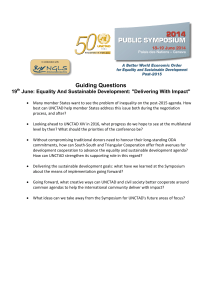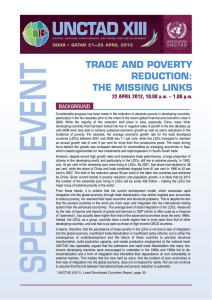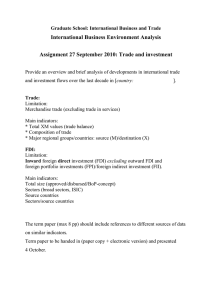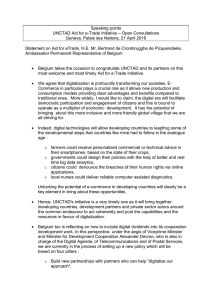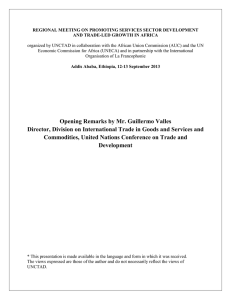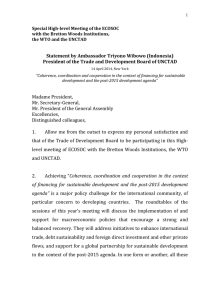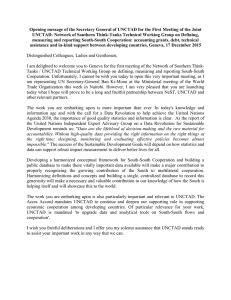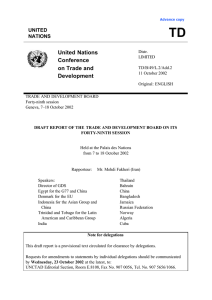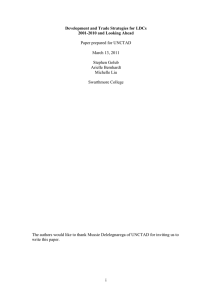Document 10461973
advertisement
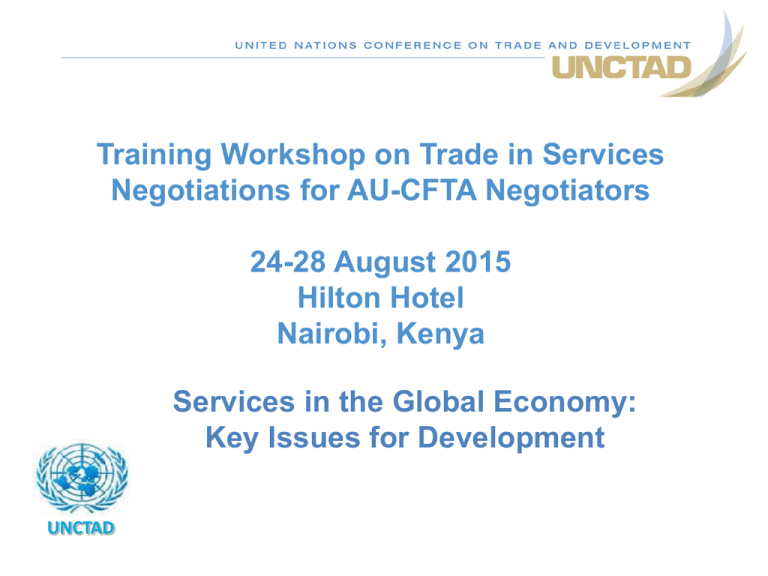
Training Workshop on Trade in Services Negotiations for AU-CFTA Negotiators 24-28 August 2015 Hilton Hotel Nairobi, Kenya Services in the Global Economy: Key Issues for Development UNCTAD Outline 1. Trends 2. Linkage between services and development 3. Factors promoting globalization of services 4. Regulatory and institutional issues 5. Concluding remarks 2 1. Trends (GDP) Contribution of services to GDP by region, 1980 and 2012 % 3 Source: UNCTAD Stat 1. Trends (GDP) LDCs’ GDP distribution in 2011 (percentage) 100% 80% 60% 40% 20% 0% Least developed LDCs: Africa and countries Haiti LDCs: Asia Agriculture Source: UNCTADstat. 4 Industry LDCs: Islands Services World 1. Trends (Employment) Contribution of services to global employment, 2000 and 2013, (percentage) Services 39 Industry 21 Services 45 Industry 23 Agriculture 40 Agriculture 32 2000 2013 Source: ILO, 2014, Global Employment Trends 2014: Ris of a Jobless Recovery? 5 1. Trends (Trade) Exports of commercial services by region, 2008-2014 (2008=100) 150 140 130 120 110 100 90 80 2008 2009 2010 World Transition economies Developing economies: Africa Developing economies: Asia Source: UNCTAD Stat. 6 2011 2012 2013 Developing economies Developed economies Developing economies: America 2014 1. Trends (Trade) Exports of commercial services from developing countries by category, 2008-2014 (2008=100) 250 230 210 190 170 150 130 110 90 70 50 2008 2009 2010 Goods-related services Travel 2011 2012 2013 2014 Transport Construction Insurance and pension services Financial services Charges for the use of intellectual property n.i.e. Telecommunications, computer, and information services Other business services Personal, cultural, and recreational services 7 Source: UNCTAD Stat. 1. Trends (Trade) 50 Exports of commercial services from Africa and LDCs by category, percentage (2013) 45 40 35 30 25 20 Developing Africa 15 10 5 0 Source: UNCTAD Stat. 8 LDCs 1. Trends (Trade) Exports of commercial services from developed countries and Africa by category, percentage (2013) 50 45 40 35 30 25 20 15 10 5 0 Source: UNCTAD Stat. 9 Developed economies Developing Africa 1. Trends (Trade) Export of commercial services from developed countries and LDCs by category (2013) 50 45 40 35 30 25 20 15 10 5 0 Source: UNCTAD Stat. 10 Developed economies LDCs 1. Trends (Trade) Exports and imports of commercial services in LDCs (2013) Exports in LDCs, 2013 Financial services Telecom.& computer services Other business services Insurance services Construction Personal, services Imports in LDCs, 2013 Goods-related services Goodsrelated services Transport Other services Transport Other services Travel Travel Source: UNCTADstat. 11 1. Trends (Trade) Developing Regions’ Services Exports (% of Total World Exports of Services, 1980 – 2012) Source: UNCTAD Stat. 12 1. Trends (Trade) Trade statistics does not capture Modes 3 and 4 (commercial presence, and presence of natural persons) Services trade increasingly occurs through these modes. UNCTAD estimates the value of all service sales by affiliates at $18 trillion in 2014, nearly four-times greater than global cross-border services exports. In 2012, services accounted for 63 per cent of global FDI stock. Cross-border movement of people supplying services (Mode 4) is particularly important in professional and business services, as well as services related to agriculture, manufactures and mining. Also, statistics do not reflect full importance of services value added embedded in exports of goods (45% in 2009) Therefore, the importance of service trade is largely underestimated 13 2. Linkage between services and development Fundamental support to the economy Important source of employment, particularly for women Essential to efficient functioning of productive capabilities and a determinant of competitiveness Contribution to innovation and development Knowledge, technology and innovation services promote diversification, structural transformation and sustained growth and development Knowledge intensive economic activities are services or have high content of services Contribution to sustainable development goals (SDGs) Goal 3 (health), Goal 4 (education), Goal 5 (gender equality), Goal 6 (water), Goal 7 (energy), Goal 8 (economic growth and employment), Goal 9 (infrastructure), Goals 13-17 (sustainable development) 14 3. Factors promoting globalization of services Foreign direct investment (FDI) (Mode 3) Commercial presence through FDI is the major mode of supply in services FDI in services grew tenfold within 20 years to reach almost $1000 billion in 2012 outpacing agriculture and manufacturing sectors FDI in financial services, transport and communication increased sharply Migrant and remittances (Mode 4) Services exports through the temporary movement of natural persons is substantial for developing countries In 2014, developing countries received $436 billion in remittances with global remittances flows standing at $583 billion. This trade is on a rising trend inferring from a continued growth in global remittance flows. Advancement in information and communication technology (Mode 1) Emergence of international cross-border processing services (customer services, publishing, graphic design, etc) Growing e-commerce not only in goods but in services, B2B, B2C Growth of the middle class (Mode 2) Increase in international tourism, education in abroad, etc 15 3. Factors promoting globalization of services Global value chains (GVCs) and services Development of GVCs requires efficient professional, business and infrastructure services (i.e., energy, transport, telecommunication and ICT, financial services, research and development, product design and marketing) Proportion of value-added services to the gross value of exports in goods represented almost 60 per cent in developed countries and over 40 per cent for developing countries in 2011. Imported services value-added accounted for 15 per cent in developed countries, and this share had increased significantly since 1995. This has made services a major option for export diversification but opportunities are yet to be fully explored in many developing countries. 16 4. Regulatory and institutional issues Services sector needs to be regulated for the purpose of: Consumer protection Environmental protection Prudential protection (economic and financial stability) Fair competition Universal access Regulation is crucial in many service sectors regardless of whether the sector is open to trade Such regulation is needed to ensure that services markets work properly by addressing problems associated with information asymmetries, natural monopolies and externalities UNCTAD has been working on regulatory and institutional issues for infrastructural services and holding Multi-Year Expert Meeting for the last 8 years. 17 4. Regulatory and institutional issues Regulatory and institutional challenges for developing countries Developing countries have particular structural weaknesses in regulatory and institutional aspect Many regulatory agencies in developing countries are still quite fragile or non-existent It takes time and resources to build well functioning regulatory and institutional framework Yet, for liberalization of services to produce the expected benefits, effective regulation and institutional capacity is necessary 18 4. Regulatory and institutional issues Liberalization of services should support: Universal access Macro-prudential objectives Financial inclusion Fair competition Sustainable developement Liberalization of services may require international regulatory cooperation and harmonization of regulation (e.g., in transport services, professional services, financial services) 19 Concluding remarks The important of services will increase for Africa as its population and economy grow. Exports and imports of services are likely show dynamic growth for Africa. Services can be an engine of growth, diversification to knowledgeintensive activities. More liberalized the service sector is, more important to have sound regulatory and institutional framework. Liberalization of services should support universal access, macroprudential objectives, financial inclusion, fair competition and sustainable development. How do these issues translate into trade in services negotiations for AUCFTA? 20 Thank you michiko.hayashi@unctad.org 21
